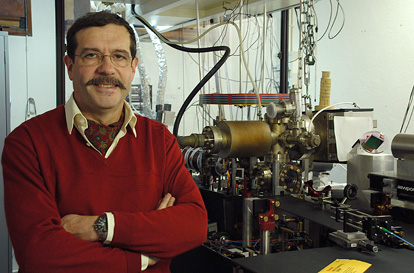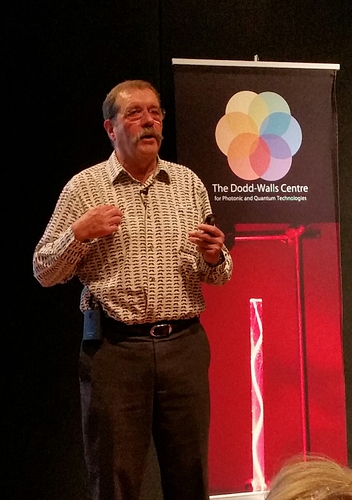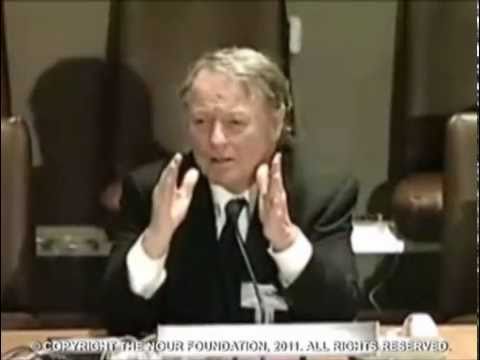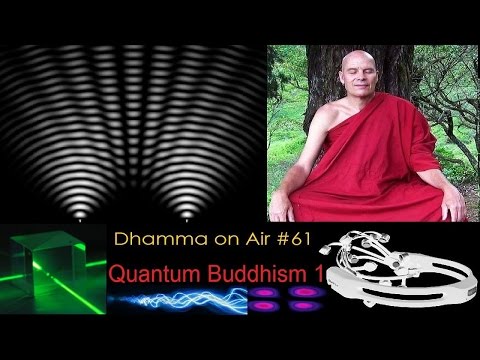…these experiments indicate that the everyday world we perceive does not exist until observed, which in turn suggests—as we shall argue in this essay—a primary role for mind in nature.
…
This notion eliminates arbitrary discontinuities and provides the missing inner essence of the physical world: all matter—not only that in living brains—is the outer appearance of inner experience, different configurations of matter reflecting different patterns or modes of mental activity.
I am wading through this post and I opened a link that I would appreciate some help in understanding?
“We present a loophole-free violation of local realism using entangled photon pairs. We ensure that all relevant events in our Bell test are spacelike separated by placing the parties far enough apart and by using fast random number generators and high-speed polarization measurements. A high-quality polarization-entangled source of photons, combined with high-efficiency, low-noise, single-photon detectors, allows us to make measurements without requiring any fair-sampling assumptions […] We estimate the degree to which a local realistic system could predict our measurement choices […] We therefore reject the hypothesis that local realism governs our experiment.” - Strong Loophole-Free Test of Local Realism
and this?:
“Local realism—that is, realism plus relativistic limits on causation—was debated by Einstein and Bohr using metaphysical arguments and recently has been rejected by Bell tests that closed all technical ‘loopholes’. For example, the ‘detection-efficiency loop- hole’ describes the possibility that the observed statistics are inaccurate owing to selection bias, and is closed by using high-efficiency detection and statistical methods that include all trials in the analysis. Recent work on device-independent quantum information shows how Bell inequality violation (BIV) can also challenge causal determinism, another topic that was formerly accessible only by metaphysics.” - Challenging local realism with human choices (the BIG Bell test Collaboration)
Do these findings have implications with regard to hidden-variable theories?:
“Hidden variables is an idea among some classical physicists that Quantum Mechanics isn’t really as random and unmeasurable as it appears but could be entirely predictable if we knew the internal rules that were being applied. These are the hidden variables.”
“Hidden variables may refer to: Confounding, in statistics, an extraneous variable in a statistical model that correlates (directly or inversely) with both the dependent variable and the independent variable.” - Wikipedia
Basically the Bell tests make many, many, measurements of the polarizations of pairs of entangled photons (two photons that, due to how they have been generated, have correlated polarizations, e.g. they both have the same polarization).
The idea is to test whether the results of the measurements could be explained by the photons carrying labels saying, for example, “if the polarizer is set at 45 degrees give a yes, if it is set at 90 degree give a no, …”. Carrying the information along with the particle is the “local realism”.
The polarizers at the detectors are set randomly. After accumulating the data the results are compared. Now (the way I’ve described it) in cases where both polarizers are set the same, the both register the same result. If they are set at different angles the result are consistent with quantum mechanics, but not with “local realism” (the particles carrying the labels). The argument is not that hard, there’s an explanation in Wikipedia:
The “loopholes” they are talking about include, for example, that if the detectors are not efficient enough then the violations might be explained thus “Oh, you only detected some of the events, if you have detected them all then it would have been different.” Of course, that’s unlikely, but one wants to be sure!
Now, it’s worth describing this in some detail, so you get some idea of how the experiments work - it’s not like someone is sitting there seeing flashes of light and checking on them. It’s all done with high-speed electronics. So it’s a bit of a leap to say “this shows that consciousness in involved”. However, much of modern physics (quantum mechanics and special and general relatively) was developed by making such speculative leaps, and then trying to test the implications, so it’s worth considering.
Here’s Alain Aspect, whose group did many heroic experiments in this area. You can see some of his lab behind him:
https://web.phys.ntu.edu.tw/colloquium/2014Fall/Joint%20colloquia_files/AlainAspect.jpg
And here’s a news article with a picture of the late John Bell:
https://www.nature.com/news/quantum-spookiness-passes-toughest-test-yet-1.18255
Sorry, can’t figure out how to make the pictures display…
I think the same argument has been applied to Newtonian Mechanics, though Chaos Theory confuses things somewhat. ![]()
"when two inanimate objects interact they simply become quantum mechanically “entangled” with one another—that is, they become united in such a way that the behavior of one becomes inextricably linked to the behavior of the other—but no actual measurement is performed […] As a matter of fact, peculiar statistical characteristics of the behavior of entangled quantum systems (namely, their experimentally confirmed violation of so-called “Bell’s and Leggett’s inequalities”) seem to rule out everything but consciousness as the agency of measurement. Some then claim that entanglement is observed only in microscopic systems and, therefore, its peculiarities are allegedly irrelevant to the world of tables and chairs.
But such a claim is untrue, as several recent studies (e.g. 2009, 2011 and 2015) have demonstrated entanglement for much larger systems. Last year, a paper reported entanglement even for “massive” objects. Moreover, quantum superposition has been observed in systems as varied as small metal paddles and living tissue. Clearly, the laws of QM apply at all scales and substrates.
What preserves a superposition is merely how well the quantum system—whatever its size—is isolated from the world of tables and chairs known to us through direct conscious apprehension. That a superposition does not survive exposure to this world suggests, if anything, a role for consciousness in the emergence of a definite physical reality." - Coming to Grips with the Implications of Quantum Mechanics
Yes, that’s where there are interesting questions. The common explanation is that the interaction with measurement devices and the environment causes “decoherence”, i.e the quantum interference effects disappear. This is, of course, an active area of research and ideas will stand or fall by experiments, not by logic, inference, reasoned contemplation, or the acceptance of a view after consideration. ![]() SuttaCentral
SuttaCentral
It will be interesting to see if someone can come up with a clear experimental test of the following idea:
OK, I managed to get Alain Aspect to appear!

Even great physics experiments involve some messy cabling…
Alain’s moustache is almost as impressive as his experiments.
Here’s a newer picture, taken in New Zealand last December. Note the cool shirt design… 
Can anyone help me to understand the following?
“peculiar […] behavior of entangled quantum systems (namely, their experimentally confirmed violation of so-called […] inequalities”) seem to rule out everything but consciousness as the agency of measurement.” - Coming to Grips with the Implications of Quantum Mechanics
I am interested in their line of reasoning - how they arrived at the following conclusion:
Why does: “the [violation] of the inequalities seem to rule out [everything but] consciousness [mentation] as the agency of measurement”?
It appears their understanding of the above is necessary if we are to understand their final conclusion:
“The claim is thus that the dynamics of all inanimate matter in the universe correspond to […] mentation […]” - Coming to Grips with the Implications of Quantum Mechanics
Back in the day, we used to think everything was made of floating balls. And once you’ve seen, classified, measured, and located all the different kinds of balls and their specific unique properties. You would know everything.
Let’s take a well known quantum experiment as an example. The double-slit experiment showed that light performs as both a wave and a particle, depending on when we observe the particles of light. Now, why would observation be a decider in the pattern of light projected after the slits? That has been the mystery of quantum physics.
The Bell Theorem suggested that it was actually due to the measurements of the experiments, that the measuring instruments themselves, due to being decided by the scientists running the experiment, inserted bias into the system, causing it to create those results that we saw. Bell theorized that, if we truly want to do a correct experiment, we must introduce randomness into the way measurements were decided.
This was what the experiment in the original article did: by sourcing the data from a hundred thousand individuals via free will, these individuals then chose the measurement settings for the scientists. That way, no bias by the scientists could be inserted into the system (though, of course, this overlooks the fact that the instruments of measurement themselves were chosen by the scientists, which arguably could have inserted bias, I digress).
The results of the given quantum experiment, run by these random strangers, was the same as it would have been if the scientists themselves had run it. This then proves Bell’s Theorem wrong: the results of the quantum experiment seemed not to be produced by the bias of the measuring apparatuses.
With this longstanding conjecture ruled out as an explanation for the mysterious means by which the results change depending on observation, what does that leave? This suggests that the strange results of the quantum experiments are actually due to the conscious observation by the scientists, themselves.
In other words, the experiment stage is not just inside the laboratory sterile’s room, but transcends time and that local space to include the conscious observation by the scientists of the raw data. This conclusion was reached as it is the only explanation left for why the experiments change based on observation.
Then, the claim for the rest of the article as follows: If the results of this tiny experiment are affected by the consciousness of the observing scientists, and if the quantum world affects more than the utterly microscopic, than it can be concluded that it is perhaps possible the reality of our own worlds is being affected by the conscious observation of these worlds.
Thus, leading us back to what the Buddha says, “Mind precedes all knowables, mind’s their chief, mind-made are they.”
This is just from wikipedia:
In quantum mechanics, the Leggett–Garg inequality is violated, meaning that the time evolution of a system cannot be understood classically. The situation is similar to the violation of Bell’s inequalities in Bell test experiments which plays an important role in understanding the nature of the Einstein–Podolsky–Rosen paradox. Here quantum entanglement plays the central role. The violation of Bell’s inequalities rules out local hidden variable theories which attempt to restore the realism in the sense that definiteness of the outcome in a single measurement can be ensured by using a supplementary variable along with the wave function which can not be obtained in the standard Copenhagen Interpretation of quantum mechanics in its various formulations.
As well as Einstein’s famous “God does not play dice” objection to quantum mechanics, there was Einstein’s still more fundamental objection that the Moon is still there when nobody looks. If the violation of the Leggett–Garg inequality can be demonstrated on the macroscopic scale, this would challenge even this notion of realism.
Its a bunch more words and terms to look up.
Basically, if this Leggett–Garg inequality can be proven to apply to objects, not just subatomic ‘objects’, then it would be ‘proven’ that the universe doesn’t exist if no one looks at it. That’s what it seems to be implying IMO.
Its not yet demonstrated, though. And, indeed, how would you ever demonstrate such a thing? Wild, man.
I have an intuition that this track will start to define Kamma, at some point in the future. Given the quantity of variables and data though, and ‘time’, it may be some time before observable experiments are possible.
Thanks for the post! 
“experimentally confirmed violation of so-called “Bell’s and Leggett’s inequalities” - (CGIQM)
Does this experimentally confirmed violation mean: the time evolution of a [quantum] system cannot be understood classically? Does this mean they discovered effects - on the quantum level - before causes?
There are all kinds of quantum phenomena that cannot be explained by classical physics. That’s why it started to be developed over 100 years ago…
One of the worries about the “spooky action and a distance” stuff is that it appears to involve instantaneous effects across potentially large distances. Another pillar of modern physics is relativity - which forbid’s faster-than-light communication (and instantaneous is faster than light…).
However, the correlations between measurements of separated photons cannot be used to transmit information faster than light. This is because the results that each measuring device registers appears random - it’s only after comparing the results (after the fact) that one can see the correlations.
Some methods of calculation of certain processes can have the appearance of effects preceding causes, and sometimes you’ll even find descriptions about “particles going back in time”, but really that’s just a way of keeping track of the calculation, and doesn’t allow us to affect something in the past.
Of course, it’s always worth looking closely to see if it’s possible to find some new way to exploit the physics to do something remarkable, and there are sure to be surprises in the future!
It’s interesting that Bernado Kastrup has been given a guest blog on Scientific American. He is a vocal and polemical opponent of scientific materialism - one of his books was called ‘Materialism is Baloney’. And incidentally all of the authors of that blog article are regular presenters at the Science and Non-Duality Conference which is held every October in San Jose.
The times, they sure are a’changing.
‘Ajahn Brahm’ has a deep understanding of physics and I would love to see a recorded discussion between someone like Dr. Kastrup and Ajahn Brahm. I feel this would shed light on quantum theory from the perspective of a senior Theravadin Elder and help us all to deepen our understanding of reality. Could the B.S.W.A. commitee ask if Ajahn would consider participating in something like this? If so, we might begin to explore a new medium - learned dialogue - through which to share the Buddha-Dhamma?



